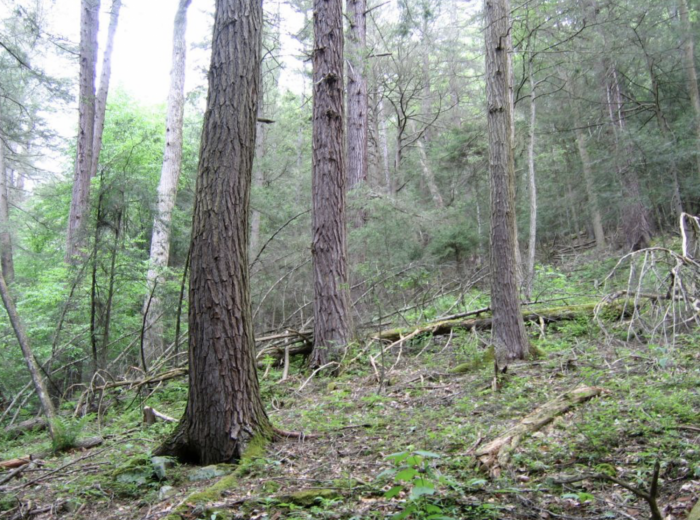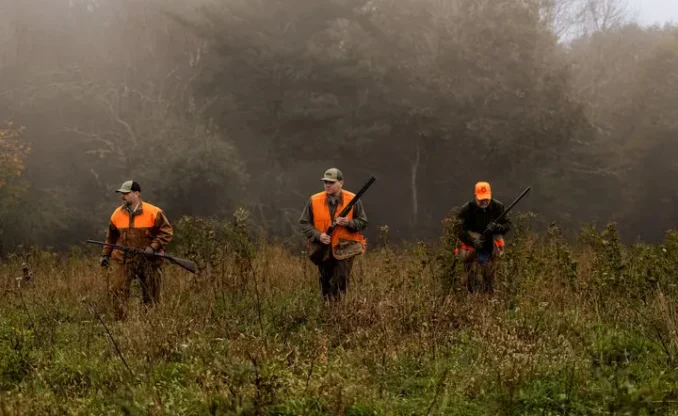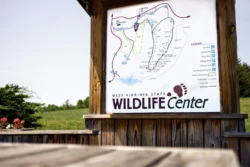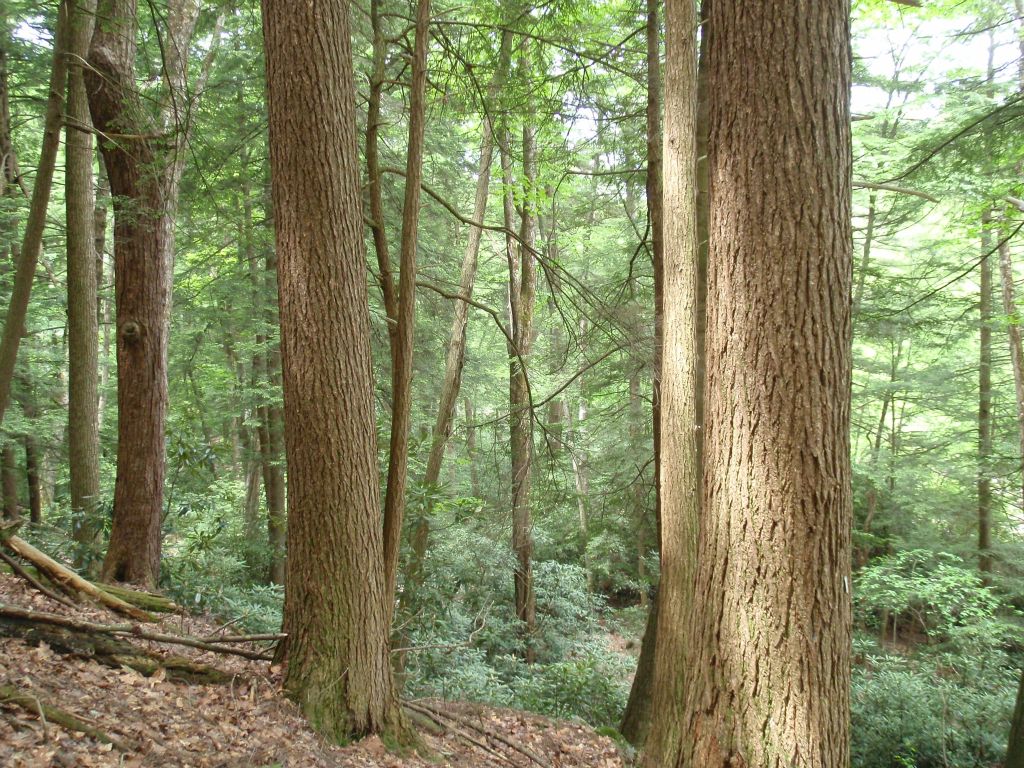Our hemlock trees are dying. In some areas of eastern West Virginia all that remains are bare skeletons. But in other areas of the state, the hemlocks still appear healthy. The fate of these majestic trees will have important ecological consequences for many natural areas in West Virginia.
Ecological Description
Upland Hemlock – Hardwood Forests are mixed evergreen-deciduous forests codominated by eastern hemlock (Tsuga canadensis). A few stands approach pure evergreen physiognomy, usually where eastern hemlock is codominant with eastern white pine (Pinus strobus) or red spruce (Picea rubens). Codominant deciduous trees can include red maple (Acer rubrum), sugar maple (Acer saccharum), yellow birch(Betula alleghaniensis), sweet birch (Betula lenta), American beech (Fagus grandifolia), tuliptree (Liriodendron tulipifera), black cherry (Prunus serotina), white oak (Quercus alba), red oak (Quercus rubra), chestnut oak (Quercus prinus) and American basswood (Tilia americana). Because it is shade tolerant, eastern hemlock is usually well represented in all strata, including seedlings, saplings, and subcanopy and canopy trees. Shrub layers are variable, ranging from nearly impenetrable tangles of great laurel (Rhododendron maximum) to scattered stems of deciduous shrubs such as wild hydrangea (Hydrangea arborescens), mapleleaf viburnum (Viburnum acerifolium), or mountain holly (Ilex montana). The low-creeping-evergreen-subshrub partridgeberry (Mitchella repens) has the highest constancy of any species in these forests, except eastern hemlock itself. Herbs are typically sparse and are well represented by ferns such as Christmas fern (Polystichum acrostichoides), New York fern (Thelypteris noveboracensis), and intermediate woodfern (Dryopteris intermedia). Bryophytes are often abundant on the forest floor; some typical species include common white cushion moss (Leucobryum glaucum), delicate fern moss (Thuidium delicatulum), flat fern moss (Hypnum imponens), and common bazzania liverwort (Bazzania trilobata).
Upland Hemlock – Hardwood Forests usually occupy mesic sites with acidic soils. They most often occur on cool, northerly aspects in lower slope positions, on soils derived from sandstone. But some associations occur in drier sites, or on high bluffs, or on less acidic soils derived from shale, or even limestone. In some areas of the state with favorable climate and soils, such as the gorge of the Gauley River and its surrounding plateaus, Upland Hemlock – Hardwood Forests have broad ecological amplitude and extend to all but the driest landscape positions. In contrast, Upland Hemlock – Hardwood Forests in the Ridge and Valley and Western Allegheny Plateau are highly localized and confined to specialized landforms such as water gaps and protected ravine slopes with low solar exposure.
Dominance by eastern hemlock usually indicates a late successional or climax seral stage. Eastern hemlock is not adapted to fire and its historical abundance and extent were probably greatly reduced during the logging era (1860-1930). Following this decline, eastern hemlock regained ground, gradually expanding up slopes and growing from the understories back into the tree canopies. But in recent decades the species is again declining in many areas of West Virginia due to infestation by the hemlock wooly adelgid (Adelges tsugae), a tiny non-native insect pest. The hemlock wooly adelgid has quickly spread from the eastern to western counties of the state, but its progress has been stalled in some high elevation areas and following cold winters.
Eastern hemlock has been called a “keystone species” or “foundation species” because it can have large effects on the habitat it occupies and on the abundance and diversity of associated flora and fauna. Its evergreen leaves provide year-round shade, which cools the understory and soil microclimate. Soils under eastern hemlock accumulate and retain more organic matter compared to nearby deciduous forests. These environmental factors interact to favor adapted plants, animals, and fungi, leading to the assembly and maintenance of distinctive ecological communities.
Animals that need these habitats
Northern saw-whet owl (Aegolius acadicus), blue-headed vireo (Vireo solitaries), blackburnian warbler (Setophaga fusca), black-throated green warbler (Setophaga virens), Swainson’s warbler (Limnothlypis swainsonii), eastern red backed salamander (Plethodon cinereus), soil centipede (Order Geophilomorpha).
Distribution
Upland Hemlock – Hardwood Forests are broadly distributed across West Virginia, but they are most common in the Allegheny and Cumberland Mountains, and less common in (and absent from many parts of) the Western Allegheny Plateau and Ridge and Valley. Locations of WVNHP and U.S. Forest Service Forest Inventory and Analysis (FIA) plots with eastern hemlock present in any strata provide a good approximation of the distribution of this tree species in West Virginia. Locations of classified plots of hemlock hardwood forests show the distribution patterns of individual associations.

Places to see and visit
Cabwaylingo State Forest, Calvin Price State Forest, Carnifex Ferry Battlefield State Park, Cathedral State Park, Gauley River National Recreation Area, Twin Falls State Park.
Conservation issues
The great ecological value of hemlock hardwood forests and the threats to these ecosystems posed by the hemlock wooly adelgid are widely recognized by conservationists. There are ongoing efforts to protect individual trees with insecticides and to slow the spread of the adelgid using biological controls. However, insecticides and introduced predators and pathogens may have unintended consequences for the native insect communities in these forests. Because control of the adelgid is not possible on all lands, the selection of priority sites to focus control efforts was an important first step. Efforts are also underway to collect seed throughout the range of eastern hemlock to preserve the genetic resources of the species. Agencies and organizations involved in these efforts include the WV Department of Agriculture, U.S. Forest Service, National Park Service, and The Nature Conservancy.
Classification
NatureServe Ecological Systems: Appalachian (Hemlock)-Northern Hardwood Forest, Central Appalachian Dry Oak-Pine Forest, Northeastern Interior Dry-Mesic Oak Forest, Southern and Central Appalachian Cove Forest, South-Central Interior Mesophytic Forest
| USNVC Association WV Scientific Name [Common Name] | Code | G Rank | S Rank |
| Tsuga canadensis – Fagus grandifolia – Quercus alba / Polystichum acrostichoides Forest [Western Plateaus Hemlock – Hardwood Forest] | CEGL005043 | G3? | S3 |
| Tsuga canadensis – Betula alleghaniensis – Prunus serotina / (Rhododendron maximum) Forest [Allegheny Mountains Hemlock – Hardwood Forest] | CEGL006206 | G4? | S3 |
| Tsuga canadensis – Pinus strobus – Quercus alba / Mitchella repens Forest [Greenbrier Valley Hemlock – White Pine Forest] | CEGL006304 | G4? | S2 |
| Tsuga canadensis – Quercus prinus / Vaccinium pallidum / Gaultheria procumbens Forest [Hemlock – Chestnut Oak Forest] | CEGL006923 | G3 | S3 |
| Tsuga canadensis – Liriodendron tulipifera – Betula lenta / Rhododendron maximum Forest [Hemlock – Hardwood / Great Laurel Acidic Cove Forest] | CEGL007543 | G5 | S4 |
| Betula alleghaniensis – (Tsuga canadensis, Liriodendron tulipifera) / Rhododendron maximum Forest [Yellow Birch (-Hemlock, Tuliptree) Cold Cove Forest] | CEGL007861 | G3 | S2 |
| Tsuga canadensis – Tilia americana / Hydrangea arborescens / Polystichum acrostichoides Forest [Rich Hemlock – Hardwood Forest] | CEGL008407 | G4 | S2 |
| Quercus prinus – (Tsuga canadensis) / Oxydendrum arboreum / Rhododendron catawbiense – Rhododendron maximum Forest [Chestnut Oak (- Hemlock) / Catawba Rosebay Forest] | CEGL008524 | G4 | S2 |
Key to Associations
- Hemlock – hardwood forests codominated by Quercus prinus, occupying relatively dry sites
- Hemlock – hardwood forests lacking or with low cover (< 20%) of Quercus prinus , occupying relatively mesic sites
- Hemlock –chestnut oak forests with the evergreen shrub Rhododendron catawbiense abundant in the tall shrub layer. Known only from the gorges of the New, Meadow, and Gauley Rivers in south-central WV. Quercus prinus – (Tsuga canadensis) / Oxydendrum arboreum / Rhododendron catawbiense – Rhododendron maximum Forest [Chestnut Oak (- Hemlock) / Catawba Rosebay Forest]
- Hemlock – chestnut oak forests lacking Rhododendron catawbiense.. Widespread (but localized) at low-middle elevations across the state. Tsuga canadensis – Quercus prinus / Vaccinium pallidum / Gaultheria procumbens Forest [Hemlock – Chestnut Oak Forest]
- Hemlock – hardwood forests with Betula alleghaniensis common.
- Hemlock – hardwood forests lacking or with low cover of Betula alleghaniensis
- Hemlock – yellow birch forests at higher elevations in the Allegheny Mountains. Liriodendron tulipifera usually absent. Tsuga canadensis – Betula alleghaniensis – Prunus serotina / (Rhododendron maximum) Forest [Allegheny Mountains Hemlock – Hardwood Forest]
- Hemlock – yellow birch forests in cold coves at lower elevations. Liriodendron tulipifera usually common. Betula alleghaniensis – (Tsuga canadensis, Liriodendron tulipifera) / Rhododendron maximum Forest [Yellow Birch (-Hemlock, Tuliptree) Cold Cove Forest]
- Hemlock – hardwood forests with Tilia americana common. Herb layer is usually diverse, with some species indicative of enriched soils. Tsuga canadensis – Tilia americana / Hydrangea arborescens / Polystichum acrostichoides Forest [Rich Hemlock – Hardwood Forest]
- Hemlock – hardwood forests without Tilia americana. Soils are strongly acidic and nutrient poor.
- Hemlock – hardwood forests with high cover by Rhododendron maximum in the tall shrub layer. Tsuga canadensis – Liriodendron tulipifera – Betula lenta / Rhododendron maximum Forest [Hemlock – Hardwood / Great Laurel Acidic Cove Forest]
- Hemlock – hardwood forests without much Rhododendron maximum.
- Hemlock – hardwood forests with Pinus strobus codominant. Forests of the Greenbrier Valley and possibly elsewhere where Pinus strobus is native. Tsuga canadensis – Pinus strobus – Quercus alba / Mitchella repens Forest [Greenbrier Valley Hemlock – White Pine Forest]
- Hemlock – hardwood forests without Pinus strobus. Forests of the Western Allegheny Plateau and Cumberlands. Tsuga canadensis – Fagus grandifolia – Quercus alba / Polystichum acrostichoides Forest [Western Plateaus Hemlock – Hardwood Forest]









